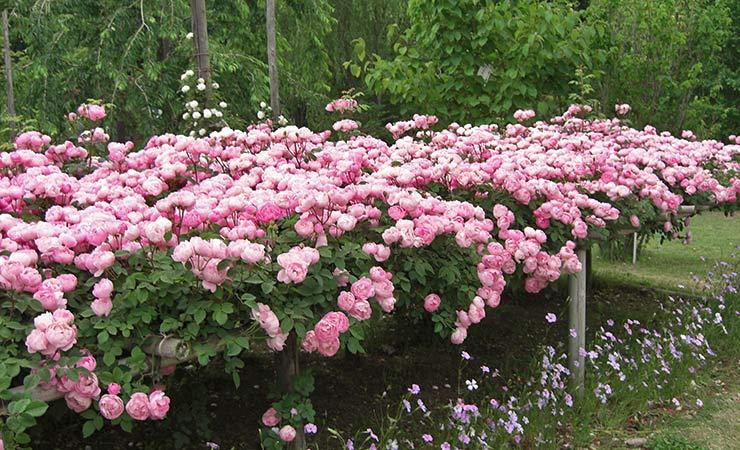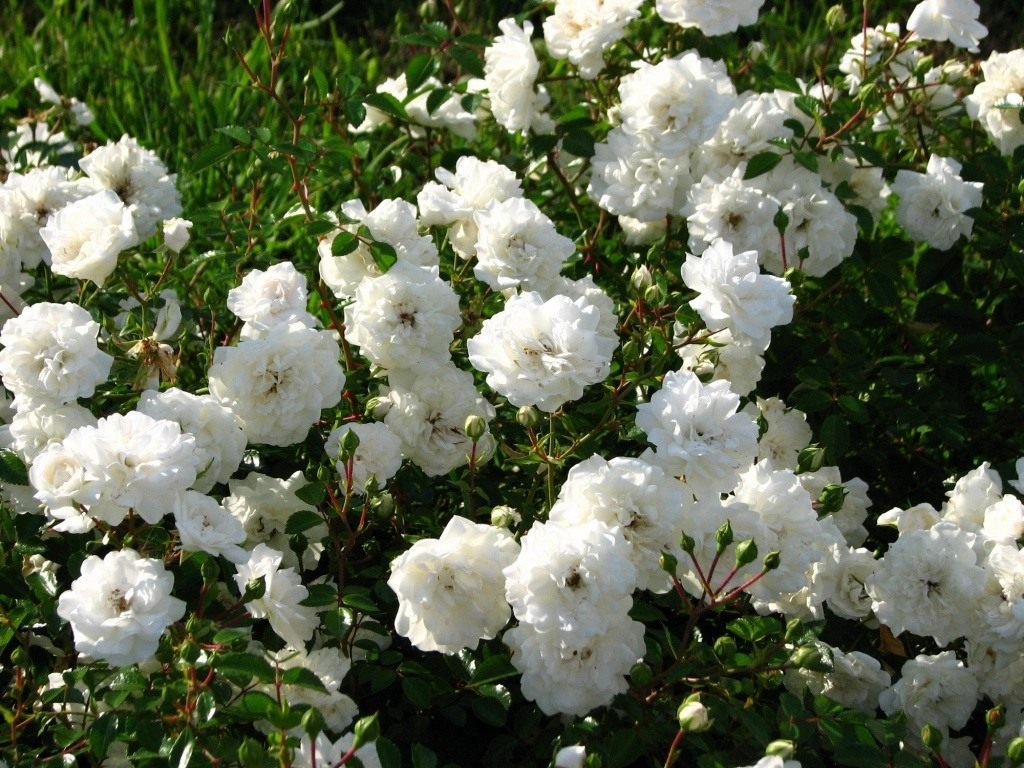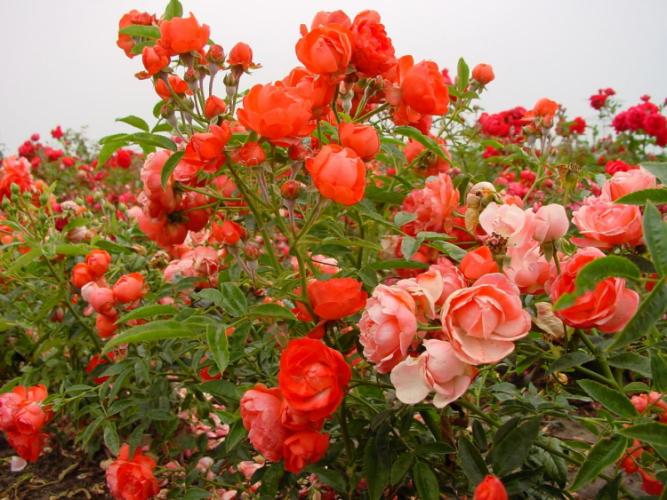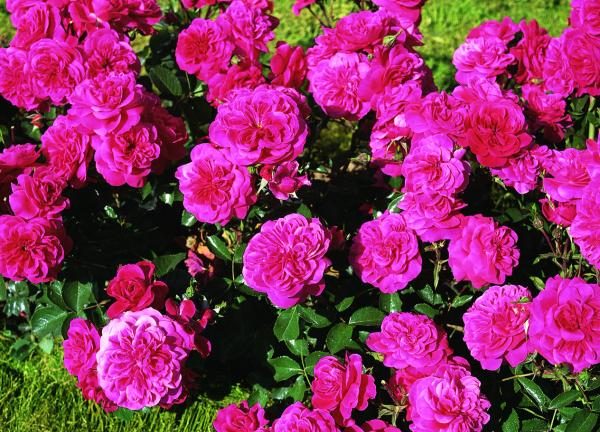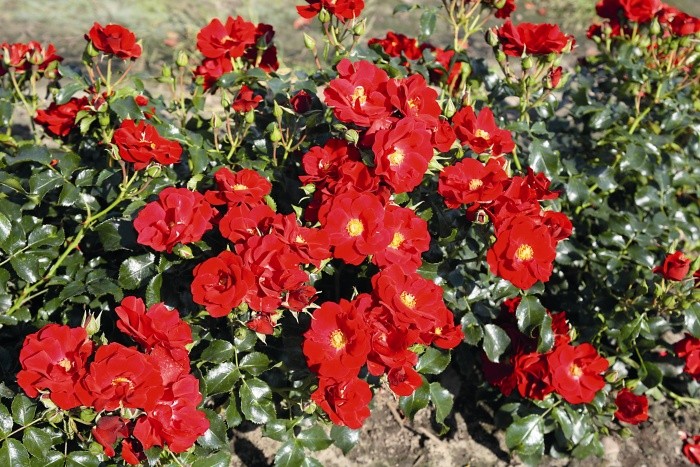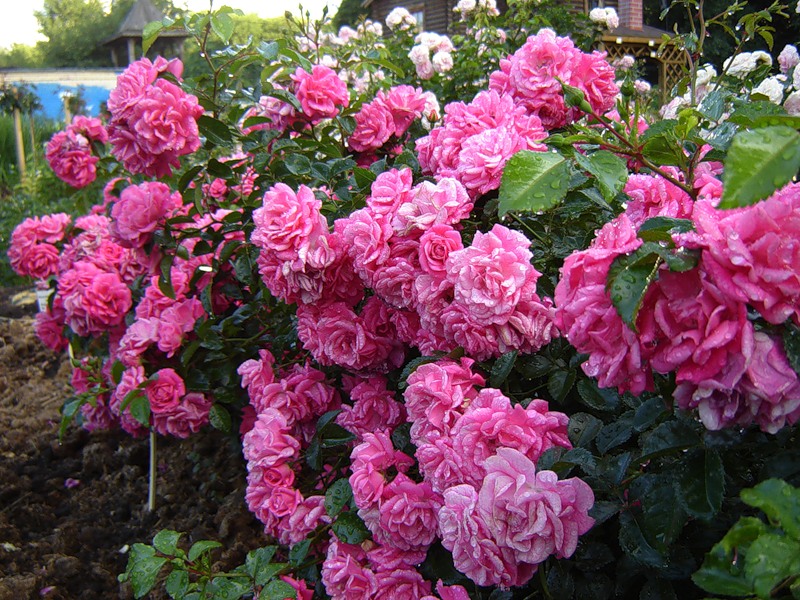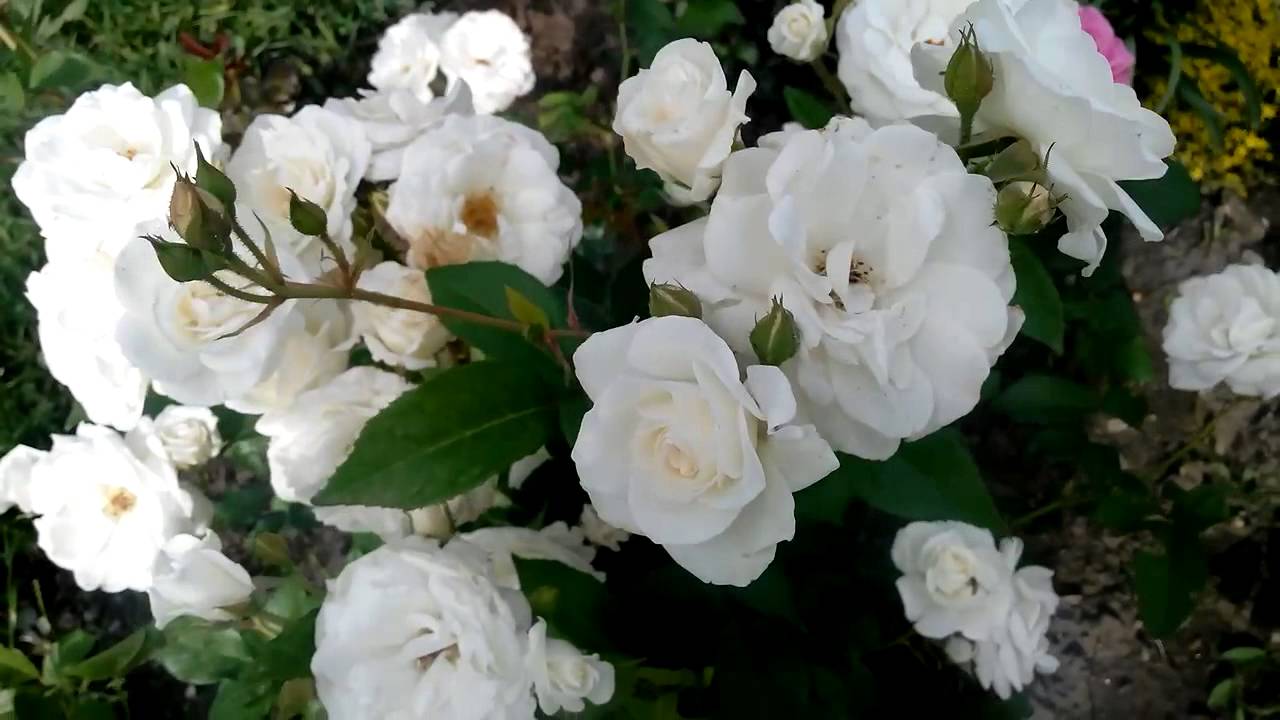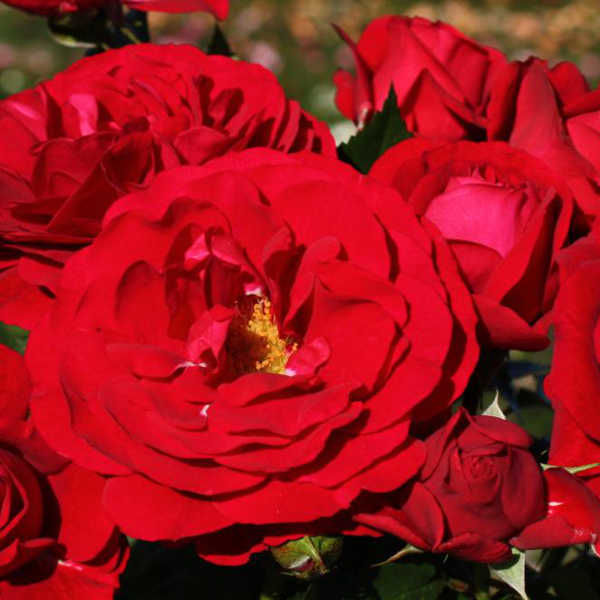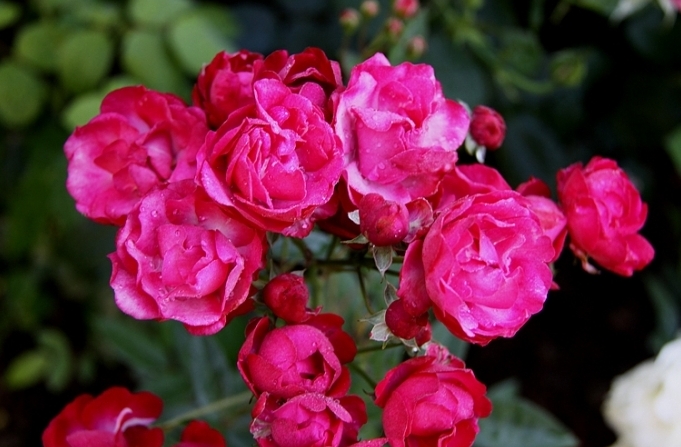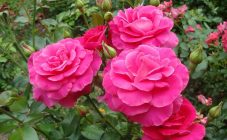Content:
Ground cover roses began to be planted in gardens and cottages relatively recently. However, it is worth knowing that the ancestors of this type of plant were such roses as Vihura and Wrinkled. They began to be dealt with 2 centuries ago. Modern species have perfectly adapted to natural conditions. They are actively used in the economy and business.
Ground cover roses: general information
Ground cover roses have wavy stems, their length reaches 2 meters. On these bases, petals develop, covering the soil. Hence the name of the representatives of this family of roses came from.
What does a creeping rose look like?
The plant grows in width by forming long, winding shoots. In season, the shoots are covered with buds with a brush-like arrangement. Flower diameter is about 10-50 mm.
Ground cover roses as a separate species of ornamental plants appeared in the middle of the last century. After experiments on earlier representatives of this species - Rosa Vihura and Wrinkled - in 1919 a new variety was bred under the name Max Graf. Later, The Fairy and Nozomi, Swany, Fiona, Red Blanket and Rosy Cushion types appeared. Game Bird and County were introduced in the 1980s. Later, Meiland Star Roses released a whole series of plants called Landscape Roses.
Plant characteristic
Creeping roses are a low-growing type of ornamental plant that has a characteristic winding shoot up to 4 m long. There are varieties that bloom only once, but there are also species with multiple flowering. They are especially popular. In addition, it is worth highlighting a light and pleasant smell.
Dr. David Gerald Hession lists four subgroups of roses:
- The first is small spreading plants 30-45 cm high and up to 1.5 m wide.
- The second - large species with stems more than 45 cm in height and a growth width of more than 1.5 m.
- The third is small drooping flowers up to 1 m high and up to 1.5 m wide.
- Fourth - large drooping species with a width of more than 1.5 m and a height of 1 m and more.
Plant species (description)
Thanks to selection, creeping roses have many different types. They all have unique properties. For example, some people tolerate frost well. Other plants are well protected from disease.
Rose Sea Foam
It blooms well from June to early winter. Due to their frost resistance qualities, flowers can sometimes linger longer, until about January. The first fruits on this rose may appear as early as early summer. At first, they are slightly pinkish buds, but then completely turn white. The flowers reach 6 cm in diameter and smell very nice. The petals have a characteristic oval shape and a shiny appearance. Some shoots are up to 2 m long.
Rose Sonnenshirm
The bush of the plant consists of many inflorescences. Terry yellow petals can be seen on them. All of them create flowers of a slightly rounded shape. The height of the bush is 60-70 cm, the diameter of the flower reaches 7 cm.
Rose Morsdag
A ground cover plant with a growth width of up to 75 cm. The variety reaches a height of 40-50 cm. A red flower with a diameter of about 5 cm. Frost-resistant. It blooms more than once, but it does not tolerate rain well. Can tolerate diseases such as black spot or powdery mildew.
Rose Mirato
It is pink in color with a bush height of about 90-100 cm.The variety grows up to 100 cm wide.It has dark green leaves and dark pink flowers. On the brush there are from 5 to 15 buds, which can bloom several times a year, but when frost comes, flowering stops.
Rose Red Cascade
In height, the variety can reach about 50 cm. In width it grows up to 240 cm. In addition, it is important to know that Red Cascade should grow with support, since otherwise it turns out to be a short and weak bush. In general, these are ground cover roses that bloom all summer. Up to 25 inflorescences develop on one brush. The leaves are small and have a characteristic glossy appearance.
Rose Red Velvet
Red Velvet is dark red in color, reaching a height of 150-180 cm and a width of 70-80 cm. Has a fairly good resistance to diseases. The bush gives about 35 flowers with double petals. Some flowers reach up to 14 cm in diameter. Shoots have thorns, which, depending on the position, change their shape.
Rose Bessie
The variety is orange in color with a flower with a diameter of 5 cm. Rose Bessie was bred in 1998. Plant height is about 50 cm, while the width is no more than 70 cm. Withstands temperatures down to -17 ° C. Thus, successful development of the variety and lush flowering can be expected.
Rose Orange Morsdag
Orange color is characteristic. It grows up to 50 cm in height, up to 75 cm in width. It is quite resistant to diseases, but begins to rot in unfavorable weather conditions. This is especially true for high humidity. Be that as it may, with good care, the seedlings develop well.
Rose Lilac rain
The flowers of the plant are easy to identify as they are either mauve or lilac in color. The height of the plant bush often reaches 100 cm. In width it grows to 75-80 cm. The variety is not afraid of hot weather or constant rains. The bush grows evenly and not very sprawling.
Rose fuchsia
The Fuchsia bush can grow up to 1.2 m wide, while the plant height is about 60 cm. On the shoots you can see double flowers with a diameter of about 5 cm. From each bud, a crimson flower blooms, in which up to 15 petals.
Rose Snow Ballet
White Rose Ballet grows to 60 cm in height and 150 cm in width. It gets sick quite rarely, but in unfavorable conditions it can become stained. One flower holds up to 25 cup-shaped petals. The buds open slowly and have a greenish tint.
Rose Matador
A red flower that almost doesn't get sick. The height of the bush reaches 70 cm. The width is about 60 cm. The petals have a bright red hue, inside the flower there is a yellow stamen. The bush can self-clean. The leaves are glossy and dark green in color.
Rose Nina Poulsen
Blooms from July to September. The shape of the bushes is either lodging or drooping. Plant height 50-70 cm. It keeps well in winter and perfectly resists diseases. Most often, Nina Poulsen becomes a decoration for slopes or lawns.
Rose Palmengarten Frankfurt
The variety is pink. It reaches a height of 80 cm, while the width of the growth is 125 cm. The flowers are bowl-shaped and often become an adornment of landscape design. Fruits appear in clusters up to 30 pieces. Also has a very persistent color. However, disease prevention should be carried out periodically.
Rose Amber Sun
The average height of a flower is 60 cm. It does not grow much in width, only up to 50 cm. The top has a diameter of about 6 cm. The petals are yellow with an admixture of copper. Grows best in temperatures between -1 ° C and -17 ° C.
Rose kent
The flower is painted white. The height and width of the bush are 75 and 125 cm, respectively. The plant belongs to scrubs. The flowers of the variety are small, double. When blooming, they smell pleasantly. Together with dark green leaves, the bush perfectly covers the soil during mass planting.
Rose Fiona
The color of Fiona's fruit is scarlet. Its diameter is usually 8 cm. The bush is very large. The height reaches 100 cm, while the width is no more than 200 cm. It can withstand temperatures down to -17 ° C.
Rose Bordeaux
It blooms repeatedly and with a large number of flowers that have a saucer shape and a double surface. They reach 10 cm in diameter. The color is dark red. Bordeaux does not have a strong aroma. The height and width of the bush reach 80 and 50 cm, respectively.
Rose Amber Carpet
The color is amber yellow. The width of the bush sometimes reaches 150 cm, while the plant can develop up to 90 cm in height. The flowers are spherical. The leaves of the stems are neat and dark green in color. It is worth noting the small number of thorns on the plant.
Rose Morsdag pink
From the name it is clear that the rose flower is pink. A variety is used for landscaping a plot of land. The bush can reach a height of 60 cm. The aroma of the flower is weak. The size of the fruit is no more than 8 cm in diameter. Morsdag pink is a winter-hardy and repeatedly flowering plant.
Agrotechnics: features of planting and crop care
In order for the planting material to develop well, it is necessary to plant it correctly and take good care of it. When choosing a landing site, the following conditions should be taken into account:
- the best place for seedlings is a place that receives a lot of sunlight throughout the day;
- black soil or loam is suitable as a soil;
- ground cover roses do not like wet soil;
- the soil should not be too alkaline;
- when planting, you should give the plants enough space for development.
2-3 hours before planting, it is better to dip the roots of planting roses into water, where you first need to add any growth stimulant. Broken branches and old leaves should also be removed from the planting material. In addition, you should pay attention to the roots. It is better to cut off damaged and blackened ones completely, but the rest must be shortened to 30 cm. The roots of the rose must be constantly in the water until planting.
The landing hole is dug about 60 cm in diameter and 30 cm deep. After preparing the site, you need to create a planting mixture. To do this, you need a bucket of peat, a bucket of sod land and three handfuls of bone meal, and fill the bottom of the hole with the prepared material. A plant is installed on top, the roots of which are carefully straightened. The soil is poured out on top of the roots, while the root collar should be underground at a depth of 2-3 cm. All this is carefully compacted and then watered with water. The amount of liquid will be approximately 10 liters. After planting, the soil is mulched with peat or humus.
Cropping and rejuvenating the culture:
- some old shoots are removed every spring;
- every 6-7 years, preventive pruning of all shoots is carried out, shortening all shoots up to 15 cm in spring.
Propagation of ground cover varieties of roses is carried out by cuttings. In late summer or early autumn, it is necessary to cut the ripe shoots of the plant, making incisions under the lower bud. After that, all needles and leaves at the bottom of the shoots are removed. The prepared material is placed in a reservoir with a liquid and a growth stimulator. At the last stage, a groove is dug up to a depth of 15 cm. Sand is poured into the bottom. Shoots are placed on top at a distance of 15 cm from each other. Then the hole is filled up and the landing site is constantly watered.
Application in landscape design
Plants are great for creating beautiful flower arrangements on your lawn. They are also used as a decoration for flower beds or paths, where plants with a neat and compact flowering nature are best suited.
This type of rose is planted in rose gardens near other plants to create various compositions.You can often find low-growing roses that are planted near stones. In the future, a beautiful rockery appears.
Creeping roses will fit well in the interior of stone buildings and multi-level gardens. Also, ground cover varieties can be planted in flowerpots, hanging baskets, and used in wall decoration. The features of low-growing roses are used with pleasure by professional designers in creating a landscape and amateur gardeners.
